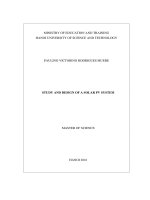Thiết kế hệ thống năng lượng mặt trời.
Bạn đang xem bản rút gọn của tài liệu. Xem và tải ngay bản đầy đủ của tài liệu tại đây (8.26 MB, 96 trang )
Country
Per capita consumption
(kwh/year)
USA
13467
China
2986
India
714
Currently Installed Generation
Capacity
2,09,276.04 MW = 2x109X
Source of Power
Share in MW
Fossil Fuels
140206
Hydro-Large
39291
Renewable Sources
24998
Nuclear
4780
TOTAL
2,09,276
% share in Generation
12%
Fossil
Fuels
2%
HydroLarge
19%
67%
Renewable
Sources
Nuclear
India's power generation capacity will need to scale up Presently it is 209 GW
by 2030 it will be over 460 GW
at 6% growth rate
Source: CEA, Annual Report
Max Demand
140090 MW
Supply
125234 MW
Deficit
14856 MW
%age deficit
10.6
Reference= />
Most parts of India receive good solar
radiation 5-7 kWh/sq. m/day
Within 6 hours deserts receive more
energy from the sun than humankind
consumes within a year – Gerhard Knies
I = 6 kwh/m2/day or 250w/m2
Efficiency = 15%
=> Power Produced = 37.5 W/m2
i.e. 37.5 MW/KM2
i.e. 1 GW/25 KM2
=>Thar desert area is 2.28 Lac KM2
(0.28 Million KM2)
So now you can imagine the potential!!!
Mission aims to achieve grid tariff parity by 2022 through
Cost reduction
Research and development
Local manufacturing and supporting infrastructure
Application Segment Target for Phase
Cumulative Target
Cumulative Target
for Phase II
for Phase III
(2013-17)
(2017-22)
1,100 MW
4,000 MW
20,000 MW
200 MW
1,000 MW
2,000 MW
7 million sq.m.
15 million sq. m.
20 million sq. m.
I (2010-13)
Grid Solar Power
incl. Roof Top
Off. Grid Solar
Applications
(inc. Rural Solar Lights)
Solar Collectors
/>
Solar capital of India with Asia’s largest solar park
More than 600 MW solar photovoltaic installations
Government launched special solar energy educational
Programs to full fill increasing demand of technical experts
Creating employment of 45,000 People in renewable energy sector
Ambitious plan of generating 100,000 Million units of clean green energy
annually
Best way to learn is looking at
High Electric bills
Increasing electricity tariff rates
Frequent electricity cut off
No contribution in environment saving
What if we used other sources of
energy to power our house !!!
Which are…
Free of cost (just requires initial investment)
Provides more reliability
Helps in contributing for saving environment
Lets see how we can work it out….
Advantages of solar energy –
Locally available
Free source of unlimited energy
If we want to power your house / this lecture
hall by using solar power
Then,
1) How will we proceed ?
2) What will be the system size and cost?
3) What other systems we will have to integrate ?
4) What will be the methodology of sizing of each equipment ?
5) What precautions we will have to take and how much the
overall system will cost?
1. Solar radiation assessment
2. Site survey and estimating maximum available energy
3. Understanding Photovoltaic technology
4. Requirement analysis
5. Determine load, power and energy consumption
6. System concept development
7. PV array and battery selections
8. Charge controller and inverter selection
Install and Run Pvsyst on your laptops
energy received from sun on a unit area perpendicular
to the rays of sun
Radiation is inversely proportional to square of the distance
At the mean distance of sun and earth, rate at which energy is received
from sun on unit area perpendicular to rays of sun is solar constant
Its value is 1367 W/m2 = Isc
Beam radiations (Direct )
Diffused radiations (Diffuse from sky + Reflected from ground)
Global (Beam+Diffused)
Measuring solar radiations









